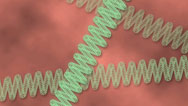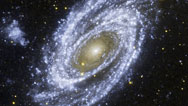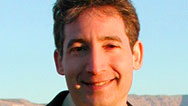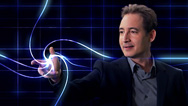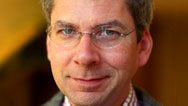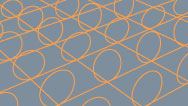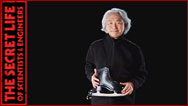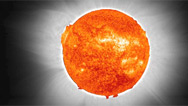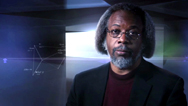
The Elegant Universe: Pt 2
String's the Thing: Do miniscule vibrating strands of energy hold the key to a unified theory of physics? Airing July 18, 2012 at 9 pm on PBS Aired July 18, 2012 on PBS
- Originally aired 10.28.03
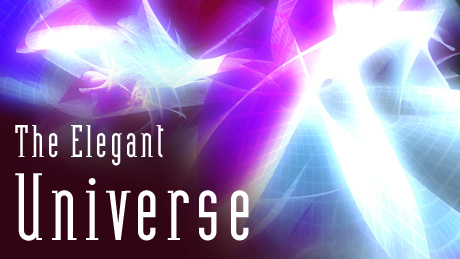
Program Description
Transcript
The Elegant Universe: Part 2
PBS Airdate: October 28, 2003
NARRATOR: Now, on NOVA, take a thrill ride into a world stranger than science fiction, where you play the game by breaking some rules, where a new view of the universe pushes you beyond the limits of your wildest imagination. This is the world of "string theory," a way of describing every force and all matter from an atom to earth, to the end of the galaxies—from the birth of time to its final tick, in a single theory, a "Theory of Everything." Our guide to this brave new world is Brian Greene, the bestselling author and physicist.
BRIAN GREENE (Columbia University): And no matter how many times I come here, I never seem to get used to it.
NARRATOR: Can he help us solve the greatest puzzle of modern physics—that our understanding of the universe is based on two sets of laws that don't agree?
NARRATOR: Resolving that contradiction eluded even Einstein, who made it his final quest. After decades, we may finally be on the verge of a breakthrough. The solution is strings, tiny bits of energy vibrating like the strings on a cello, a cosmic symphony at the heart of all reality. But it comes at a price: parallel universes and 11 dimensions, most of which you've never seen.
BRIAN GREENE: We really may live in a universe with more dimensions than meet the eye.
AMANDA PEET (University of Toronto): People who have said that there were extra dimensions of space have been labeled crackpots, or people who are bananas.
NARRATOR: A mirage of science and mathematics or the ultimate theory of everything?
S. JAMES GATES, JR. (University of Maryland): If string theory fails to provide a testable prediction, then nobody should believe it.
SHELDON LEE GLASHOW: Is that a theory of physics, or a philosophy?
BRIAN GREENE: One thing that is certain is that string theory is already showing us that the universe may be a lot stranger than any of us ever imagined.
NARRATOR: Coming up tonight...
GABRIELE VENEZIANO (CERN): We accidentally discovered string theory.
NARRATOR: ...the humble beginnings of a revolutionary idea.
LEONARD SUSSKIND (Stanford University): I was completely convinced it was going to say, "Susskind is the next Einstein."
JOSEPH LYKKEN (Fermilab): This seemed crazy to people.
LEONARD SUSSKIND: I was depressed, I was unhappy. The result was I went home and got drunk.
NARRATOR: Obsession drives scientists to pursue the Holy Grail of physics, but are they ready for what they discover? Step into the bizarre world of the Elegant Universe right now.
BRIAN GREENE: It's a little known secret but for more than half a century a dark cloud has been looming over modern science. Here's the problem: our understanding of the universe is based on two separate theories. One is Einstein's general theory of relativity—that's a way of understanding the biggest things in the universe, things like stars and galaxies. But the littlest things in the universe, atoms and subatomic particles, play by an entirely different set of rules called, "quantum mechanics."
These two sets of rules are each incredibly accurate in their own domain but whenever we try to combine them, to solve some of the deepest mysteries in the universe, disaster strikes.
Take the beginning of the universe, the "big bang." At that instant a tiny nugget erupted violently. Over the next 14 billion years the universe expanded and cooled into the stars, galaxies and planets we see today. But if we run the cosmic film in reverse, everything that's now rushing apart comes back together, so the universe gets smaller, hotter and denser as we head back to the beginning of time.
As we reach the big bang, when the universe was both enormously heavy and incredibly tiny, our projector jams. Our two laws of physics, when combined, break down.
But what if we could unite quantum mechanics and general relativity and see the cosmic film in its entirety?
Well, a new set of ideas called "string theory" may be able to do that. And if it's right, it would be one of the biggest blockbusters in the history of science. Someday, string theory may be able to explain all of nature, from the tiniest bits of matter to the farthest reaches of the cosmos, using just one single ingredient: tiny vibrating strands of energy called strings.
But why do we have to rewrite the laws of physics to accomplish this? Why does it matter if the two laws that we have are incompatible? Well, you can think of it like this. Imagine you lived in a city ruled not by one set of traffic laws, but by two separate sets of laws that conflicted with each other. As you can see it would be pretty confusing.
To understand this place, you'd need to find a way to put those two conflicting sets of laws together into one all-encompassing set that makes sense.
MICHAEL DUFF (University of Michigan): We work on the assumption that there is a theory out there, and it's our job, if we're sufficiently smart and sufficiently industrious, to figure out what it is.
STEVEN WEINBERG (University of Texas at Austin): We don't have a guarantee—it isn't written in the stars that we're going to succeed—but in the end we hope we will have a single theory that governs everything.
BRIAN GREENE: But before we can find that theory, we need to take a fantastic journey to see why the two sets of laws we have conflict with each other. And the first stop on this strange trip is the realm of very large objects.
To describe the universe on large scales we use one set of laws, Einstein's general theory of relativity, and that's a theory of how gravity works. General relativity pictures space as sort of like a trampoline, a smooth fabric that heavy objects like stars and planets can warp and stretch.
Now, according to the theory, these warps and curves create what we feel as gravity. That is, the gravitational pull that keeps the earth in orbit around the sun is really nothing more than our planet following the curves and contours that the sun creates in the spatial fabric.
But the smooth, gently curving image of space predicted by the laws of general relativity is not the whole story. To understand the universe on extremely small scales, we have to use our other set of laws, quantum mechanics. And as we'll see, quantum mechanics paints a picture of space so drastically different from general relativity that you'd think they were describing two completely separate universes.
To see the conflict between general relativity and quantum mechanics we need to shrink way, way, way down in size. And as we leave the world of large objects behind and approach the microscopic realm, the familiar picture of space in which everything behaves predictably begins to be replaced by a world with a structure that is far less certain.
And if we keep shrinking, getting billions and billion of times smaller than even the tiniest bits of matter—atoms and the tiny particles inside of them—the laws of the very small, quantum mechanics, say that the fabric of space becomes bumpy and chaotic. Eventually we reach a world so turbulent that it defies common sense.
Down here, space and time are so twisted and distorted that the conventional ideas of left and right, up and down, even before and after, break down. There's no way to tell for certain that I'm here, or here or both places at once. Or maybe I arrived here before I arrived here.
In the quantum world you just can't pin everything down. It's an inherently wild and frenetic place.
WALTER H.G. LEWIN (Massachusetts Institute of Technology): The laws in the quantum world are very different from the laws that we are used to. And is that surprising? Why should the world of the very small, at an atomic level, why should that world obey the same kind of rules and laws that we are used to in our world, with apples and oranges and walking around on the street? Why would that world behave the same way?
BRIAN GREENE: The fluctuating jittery picture of space and time predicted by quantum mechanics is in direct conflict with the smooth, orderly, geometric model of space and time described by general relativity. But we think that everything, from the frantic dance of subatomic particles to the majestic swirl of galaxies, should be explained by just one grand physical principle, one master equation.
If we can find that equation, how the universe really works at every time and place will at last be revealed. You see, what we need is a theory that can cope with the very tiny and the very massive, one that embraces both quantum mechanics and general relativity, and never breaks down, ever.
For physicists, finding a theory that unites general relativity and quantum mechanics is the Holy Grail, because that framework would give us a single mathematical theory that describes all the forces that rule our universe. General relativity describes the most familiar of those forces: gravity. But quantum mechanics describes three other forces: the strong nuclear force that's responsible for gluing protons and neutrons together inside of atoms; electromagnetism, which produces light, electricity and magnetic attraction; and the weak nuclear force: that's the force responsible for radioactive decay.
Albert Einstein spent the last 30 years of his life searching for a way to describe the forces of nature in a single theory, and now string theory may fulfill his dream of unification.
For centuries, scientists have pictured the fundamental ingredients of nature—atoms and the smaller particles inside of them—as tiny balls or points. But string theory proclaims that at the heart of every bit of matter is a tiny, vibrating strand of energy called a string. And a new breed of scientist believes these miniscule strings are the key to uniting the world of the large and the world of the small in a single theory.
JOSEPH LYKKEN: The idea that a scientific theory that we already have in our hands could answer the most basic questions is extremely seductive.
S. JAMES GATES, JR.: For about 2,000 years, all of our physics essentially has been based on...essentially we were talking about billiard balls. The very idea of the string is such a paradigm shift, because instead of billiard balls, you have to use little strands of spaghetti.
BRIAN GREENE: But not everyone is enamored of this new theory. So far no experiment has been devised that can prove these tiny strings exist.
SHELDON LEE GLASHOW (Boston University): And let me put it bluntly. There are physicists and there are string theorists. It is a new discipline, a new—you may call it a tumor—you can call it what you will, but they have focused on questions which experiment cannot address. They will deny that, these string theorists, but it's a kind of physics which is not yet testable, it does not make predictions that have anything to do with experiments that can be done in the laboratory or with observations that could be made in space or from telescopes. And I was brought up to believe, and I still believe, that physics is an experimental science. It deals with the results to experiments, or in the case of astronomy, observations.
BRIAN GREENE: From the start, many scientists thought string theory was simply too far out. And frankly, the strange way the theory evolved—in a series of twists, turns and accidents—only made it seem more unlikely.
In the late 1960s a young Italian physicist, named Gabriele Veneziano, was searching for a set of equations that would explain the strong nuclear force, the extremely powerful glue that holds the nucleus of every atom together binding protons to neutrons. As the story goes, he happened on a dusty book on the history of mathematics, and in it he found a 200-year old equation, first written down by a Swiss mathematician, Leonhard Euler. Veneziano was amazed to discover that Euler's equations, long thought to be nothing more than a mathematical curiosity, seemed to describe the strong force.
He quickly published a paper and was famous ever after for this "accidental" discovery.
GABRIELE VENEZIANO (CERN): I see occasionally, written in books, that, uh, that this model was invented by chance or was, uh, found in the math book, and, uh, this makes me feel pretty bad. What is true is that the function was the outcome of a long year of work, and we accidentally discovered string theory.
BRIAN GREENE: However it was discovered, Euler's equation, which miraculously explained the strong force, took on a life of its own. This was the birth of string theory. Passed from colleague to colleague, Euler's equation ended up on the chalkboard in front of a young American physicist, Leonard Susskind.
LEONARD SUSSKIND: To this day I remember the formula. The formula was... and I looked at it, and I said, "This is so simple even I can figure out what this is."
BRIAN GREENE: Susskind retreated to his attic to investigate. He understood that this ancient formula described the strong force mathematically, but beneath the abstract symbols he had caught a glimpse of something new.
LEONARD SUSSKIND: And I fiddled with it, I monkeyed with it. I sat in my attic, I think for two months on and off. But the first thing I could see in it, it was describing some kind of particles which had internal structure which could vibrate, which could do things, which wasn't just a point particle. And I began to realize that what was being described here was a string, an elastic string, like a rubber band, or like a rubber band cut in half. And this rubber band could not only stretch and contract, but wiggle. And marvel of marvels, it exactly agreed with this formula.
I was pretty sure at that time that I was the only one in the world who knew this.
BRIAN GREENE: Susskind wrote up his discovery introducing the revolutionary idea of strings. But before his paper could be published it had to be reviewed by a panel of experts.
LEONARD SUSSKIND: I was completely convinced that when it came back it was going to say, "Susskind is the next Einstein," or maybe even, "the next Newton." And it came back saying, "this paper's not very good, probably shouldn't be published."
I was truly knocked off my chair. I was depressed, I was unhappy. I was saddened by it. It made me a nervous wreck, and the result was I went home and got drunk.
BRIAN GREENE: As Susskind drowned his sorrows over the rejection of his far out idea, it appeared string theory was dead.
Meanwhile, mainstream science was embracing particles as points, not strings. For decades, physicists had been exploring the behavior of microscopic particles by smashing them together at high speeds and studying those collisions. In the showers of particles produced, they were discovering that nature is far richer than they thought.
SHELDON LEE GLASHOW: Once a month there'd be a discovery of a new particle: the Rho meson, the Omega particle, the B particle, the B1 particle, the B2 particle, Phi, Omega...more letters were used than exist in most alphabets. It was a population explosion of particles.
STEVEN WEINBERG: It was a time when graduate students would run through the halls of a physics building saying they discovered another particle, and it fit the theories. And it was all so exciting.
BRIAN GREENE: And in this zoo of new particles, scientists weren't just discovering building blocks of matter. Leaving string theory in the dust, physicists made a startling and strange prediction: that the forces of nature can also be explained by particles.
Now, this is a really weird idea, but it's kind of like a game of catch in which the players like me and me are particles of matter. And the ball we're throwing back and forth is a particle of force. It's called a messenger particle.
For example, in the case of magnetism, the electromagnetic force—this ball—would be a photon. The more of these messenger particles or photons that are exchanged between us, the stronger the magnetic attraction. And scientists predicted that it's this exchange of messenger particles that creates what we feel as force. Experiments confirmed these predictions with the discovery of the messenger particles for electromagnetism, the strong force and the weak force.
And using these newly discovered particles scientists were closing in on Einstein's dream of unifying the forces. Particle physicists reasoned that if we rewind the cosmic film to the moments just after the big bang, some 14 billion years ago when the universe was trillions of degrees hotter, the messenger particles for electromagnetism and the weak force would have been indistinguishable. Just as cubes of ice melt into water in the hot sun, experiments show that as we rewind to the extremely hot conditions of the Big Bang, the weak and electromagnetic forces meld together and unite into a single force called "the electroweak."
And physicists believe that if you roll the cosmic film back even further, the electroweak would unite with the strong force in one grand "super-force." Although that has yet to be proven, quantum mechanics was able to explain how three of the forces operate on the subatomic level.
SHELDON LEE GLASHOW: And all of a sudden we had a consistent theory of elementary particle physics, which allows us to describe all of the interactions—weak, strong and electromagnetic—in the same language. It all made sense, and it's all in the textbooks.
STEVEN WEINBERG: Everything was converging toward a simple picture of the known particles and forces, a picture which eventually became known as the "Standard Model." I think I gave it that name.
BRIAN GREENE: The inventors of the Standard Model, both the name and the theory, were the toasts of the scientific community, receiving Nobel Prize after Nobel Prize. But behind the fanfare was a glaring omission. Although the standard model explained three of the forces that rule the world of the very small, it did not include the most familiar force, gravity.
Overshadowed by the Standard Model, string theory became a backwater of physics.
GABRIELE VENEZIANO: Most people in our community lost, completely, interest in string theory. They said, "Okay, that was a very nice elegant thing but had nothing to do with nature."
S. JAMES GATES, JR.: It's not taken seriously by much of the community, but the early pioneers of string theory are convinced that they can smell reality and continue to pursue the idea.
BRIAN GREENE: But the more these diehards delved into string theory the more problems they found.
JOSEPH LYKKEN: Early string theory had a number of problems. One was that it predicted a particle which we know is unphysical. It's what's called a "tachyon," a particle that travels faster than light.
JOHN H. SCHWARZ (California Institute of Technology): There was this discovery that the theory requires ten dimensions, which is very disturbing, of course, since it's obvious that that's more than there are.
CUMRUN VAFA (Harvard University): It had this massless particle which was not seen in experiments.
MICHAEL B. GREEN: So these theories didn't seem to make sense.
JOSEPH LYKKEN: This seemed crazy to people.
CUMRUN VAFA: Basically, string theory was not getting off the ground.
JOSEPH LYKKEN: People threw up their hands and said, "This can't be right."
BRIAN GREENE: By 1973, only a few young physicists were still wrestling with the obscure equations of string theory. One was John Schwarz, who was busy tackling string theory's numerous problems, among them a mysterious massless particle predicted by the theory but never seen in nature, and an assortment of anomalies or mathematical inconsistencies.
JOHN H. SCHWARZ: We spent a long time trying to fiddle with the theory. We tried all sorts of ways of making the dimension be four, getting rid of these massless particles and the tachyons and so on, but it was always ugly and unconvincing.
BRIAN GREENE: For four years, Schwarz tried to tame the unruly equations of string theory, changing, adjusting, combining and recombining them in different ways. But nothing worked. On the verge of abandoning string theory, Schwarz had a brainstorm: perhaps his equations were describing gravity. But that meant reconsidering the size of these tiny strands of energy.
JOHN H. SCHWARZ: We weren't thinking about gravity up 'til that point. But as soon as we suggested that maybe we should be dealing with a theory of gravity, we had to radically change our view of how big these strings were.
BRIAN GREENE: By supposing that strings were a hundred billion billion times smaller than an atom, one of the theory's vices became a virtue.
The mysterious particle John Schwarz had been trying to get rid of now appeared to be a graviton, the long sought after particle believed to transmit gravity at the quantum level.
String theory had produced the piece of the puzzle missing from the standard model. Schwarz submitted for publication his groundbreaking new theory describing how gravity works in the subatomic world.
JOHN H. SCHWARZ: It seemed very obvious to us that it was right. But there was really no reaction in the community whatsoever.
BRIAN GREENE: Once again string theory fell on deaf ears. But Schwarz would not be deterred. He had glimpsed the Holy Grail. If strings described gravity at the quantum level, they must be the key to unifying the four forces. He was joined in this quest by one of the only other scientists willing to risk his career on strings, Michael Green.
MICHAEL B. GREEN (University of Cambridge): In a sense, I think, we had a quiet confidence that the string theory was obviously correct, and it didn't matter much if people didn't see it at that point. They would see it down the line.
BRIAN GREENE: But for Green's confidence to pay off, he and Schwarz would have to confront the fact that in the early 1980s, string theory still had fatal flaws in the math known as "anomalies." An anomaly is just what it sounds like. It's something that's strange or out of place, something that doesn't belong.
Now this kind of anomaly is just weird. But mathematical anomalies can spell doom for a theory of physics. They're a little complicated, so here's a simple example: let's say we have a theory in which these two equations describe one physical property of our universe. Now if I solve this equation over here, and I find x=1, and if I solve this equation over here and find x=2, I know my theory has anomalies because there should only be one value for X. Unless I can revise my equations to get the same value for X on both sides, the theory is dead.
In the early 1980s, string theory was riddled with mathematical anomalies kind of like these, although the equations were much more complex. The future of the theory depended on ridding the equations of these fatal inconsistencies.
After Schwarz and Green battled the anomalies in string theory for five years, their work culminated late one night in the summer of 1984.
JOHN H. SCHWARZ: It was widely believed that these theories must be inconsistent because of anomalies. Well, for no really good reason, I just felt that had to be wrong because I, I felt, "String theory has got to be right, therefore there can't be anomalies." So we decided, "We've got to calculate these things."
BRIAN GREENE: Amazingly it all boiled down to a single calculation. On one side of the blackboard they got 496. And if they got the matching number on the other side it would prove string theory was free of anomalies.
MICHAEL B. GREEN: I do remember a particular moment, when John Schwarz and I were talking at the blackboard and working out these numbers which had to fit, and they just had to match exactly. I remember joking with John Schwarz at that moment, because there was thunder and lightning—there was a big mountain storm in Aspen at that moment—and I remember saying something like, you know, "We must be getting pretty close, because the gods are trying to prevent us completing this calculation." And, indeed, they did match.
BRIAN GREENE: The matching numbers meant the theory was free of anomalies. And it had the mathematical depth to encompass all four forces.
JOHN H. SCHWARZ: So we recognized not only that the strings could describe gravity but they could also describe the other forces. So we spoke in terms of unification. And we saw this as a possibility of realizing the dream that Einstein had expressed in his later years, of unifying the different forces in some deeper framework.
MICHAEL B. GREEN: We felt great. That was an extraordinary moment, because we realized that no other theory had ever succeeded in doing that.
JOHN H. SCHWARZ: But by now, it's like crying wolf. Each time we had done something, I figured everyone's going to be excited, and they weren't. So I, I figured...by now I didn't expect much of a reaction.
BRIAN GREENE: But this time the reaction was explosive. In less than a year, the number of string theorists leapt from just a handful to hundreds.
MICHAEL B. GREEN: Up to that moment, the longest talk I'd ever given on the subject was five minutes at some minor conference. And then, suddenly, I was invited all over the world to give talks and lectures and so forth.
BRIAN GREENE: String theory was christened "The Theory of Everything."
In early fall of 1984, I came here, to Oxford University, to begin my graduate studies in physics. Some weeks after, I saw a poster for a lecture by Michael Green. I didn't know who he was, but, then again, I really didn't know who anybody was. But the title of the lecture was something like "The Theory of Everything." So how could I resist?
This elegant new version of string theory seemed capable of describing all the building blocks of nature.
Here's how: inside every grain of sand are billions of tiny atoms. Every atom is made of smaller bits of matter, electrons orbiting a nucleus made of protons and neutrons, which are made of even smaller bits of matter called quarks. But string theory says this is not the end of the line. It makes the astounding claim that the particles making up everything in the universe are made of even smaller ingredients, tiny wiggling strands of energy that look like strings. Each of these strings is unimaginably small. In fact, if an atom were enlarged to the size of the solar system, a string would only be as large as a tree!
And here's the key idea. Just as different vibrational patterns or frequencies of a single cello string create what we hear as different musical notes, the different ways that strings vibrate give particles their unique properties, such as mass and charge. For example, the only difference between the particles making up you and me and the particles that transmit gravity and the other forces is the way these tiny strings vibrate.
Composed of an enormous number of these oscillating strings, the universe can be thought of as a grand cosmic symphony. And this elegant idea resolves the conflict between our jittery unpredictable picture of space on the subatomic scale and our smooth picture of space on the large scale.
It's the jitteriness of quantum theory versus the gentleness of Einstein's general theory of relativity that makes it so hard to bridge the two, to stitch them together. Now, what string theory does, it comes along and basically calms the jitters of quantum mechanics. It spreads them out by virtue of taking the old idea of a point particle and spreading it out into a string. So the jittery behavior is there, but it's just sufficiently less violent that quantum theory and general relativity stitch together perfectly within this framework.
It's a triumph of mathematics. With nothing but these tiny vibrating strands of energy, string theorists claim to be fulfilling Einstein's dream of uniting all forces and all matter.
But this radical new theory contains a chink in its armor.
SHELDON LEE GLASHOW: No experiment can ever check up what's going on at the distances that are being studied. No observation can relate to these tiny distances or high energies. That is to say, there ain't no experiment that could be done, nor is there any observation that could be made, that would say, "You guys are wrong." The theory is safe, permanently safe. Is that a theory of physics or a philosophy? I ask you.
MICHAEL B. GREEN: People often criticize string theory for saying that it's very far removed from any direct experimental test, and it's...surely it's not really, um, um, a branch of physics, for that reason. And I, my response to that is simply that they're going to be proved wrong.
BRIAN GREENE: Making string theory even harder to prove, is that, in order to work, the complex equations require something that sounds like it's straight out of science fiction: extra dimensions of space.
AMANDA PEET: We've always thought, for centuries, that there was only what we can see. You know, this dimension, that one, and another one. There was only three dimensions of space and one of time. And people who've said that there were extra dimensions of space have been labeled as, you know, crackpots, or people who were bananas. Well, string theory really predicts it.
BRIAN GREENE: To be taken seriously, string theorists had to explain how this bizarre prediction could be true. And they claim that the far out idea of extra dimensions may be more down to earth than you'd think.
Let me show you what I mean. I'm off to see a guy who was one of the first people to think about this strange idea. I'm supposed to meet him at four o'clock at his apartment at Fifth Avenue and 93rd Street, on the second floor. Now, in order to get to this meeting, I need four pieces of information: one for each of the three dimensions of space—a street, an avenue and a floor number—and one more for time, the fourth dimension. You can think about these as the four dimensions of common experience: left-right, back-forth, up-down and time.
As it turns out, the strange idea that there are additional dimensions stretches back almost a century. Our sense that we live in a universe of three spatial dimensions really seems beyond question. But in 1919, Theodor Kaluza, a virtually unknown German mathematician, had the courage to challenge the obvious. He suggested that maybe, just maybe, our universe has one more dimension that for some reason we just can't see.
THEODOR KALUZA (ACTOR): Look. He says here, "I like your idea." So why does he delay?
BRIAN GREENE: You see, Kaluza had sent his idea about an additional spatial dimension to Albert Einstein. And although Einstein was initially enthusiastic, he then seemed to waver, and for two years held up publication of Kaluza's paper. Eventually, Kaluza's paper was published—after Einstein decided extra dimensions were his cup of tea.
Here's the idea. In 1916, Einstein showed that gravity is nothing but warps and ripples in the four familiar dimensions of space and time. Just three years later, Kaluza proposed that electromagnetism might also be ripples. But for that to be true, Kaluza needed a place for those ripples to occur. So Kaluza proposed an additional hidden dimension of space.
But if Kaluza was right, where is this extra dimension? And what would extra dimensions look like? Can we even begin to imagine them? Well, building upon Kaluza's work, the Swedish physicist Oskar Klein suggested an unusual answer.
Take a look at the cables supporting that traffic light. From this far away I can't see that they have any thickness. Each one looks like a line—something with only a single dimension.
But suppose we could explore one of these cables way up close, like from the point of view of an ant. Now a second dimension which wraps around the cable becomes visible. From its point of view, the ant can move forwards and backwards, and it can also move clockwise and counterclockwise.
So dimensions can come in two varieties. They can be long and unfurled like the length of the cable, but they can also be tiny and curled up like the circular direction that wraps around it.
Kaluza and Klein made the wild suggestion that the fabric of our universe might be kind of like the surface of the cable, having both big extended dimensions, the three that we know about, but also tiny, curled up dimensions, curled up so tiny—billions of times smaller than even a single atom—that we just can't see them. And so our perception that we live in a universe with three spatial dimensions may not be correct after all. We really may live in a universe with more dimensions than meet the eye.
So what would these extra dimensions look like? Kaluza and Klein proposed that if we could shrink down billions of times, we'd find one extra tiny, curled up dimension located at every point in space. And just the way an ant can explore the circular dimension that wraps around a traffic light cable, in theory an ant that is billions of times smaller could also explore this tiny, curled up, circular dimension.
This idea that extra dimensions exist all around us lies at the heart of string theory. In fact the mathematics of string theory demand not one, but six extra dimensions, twisted and curled into complex little shapes that might look something like this.
MICHAEL DUFF: If string theory is right we would have to admit that there are really more dimensions out there, and I find that completely mind-blowing.
EDWARD WITTEN (Institute for Advanced Study): If I take the theory as we have it now, literally, I would conclude that the extra dimensions really exist. They're part of nature.
JOSEPH LYKKEN: When we talk about extra dimensions we literally mean extra dimensions of space that are the same as the dimensions of space that we see around us. And the only difference between them has to do with their shape.
BRIAN GREENE: But how could these tiny extra dimensions, curled up into such peculiar shapes, have any effect on our everyday world? Well, according to string theory, shape is everything.
Because of its shape, a French horn can produce dozens of different notes. When you press one of the keys you change the note, because you change the shape of the space inside the horn where the air resonates. And we think the curled up spatial dimensions in string theory work in a similar way.
If we could shrink down small enough to fly into one of these tiny six-dimensional shapes predicted by string theory we would see how the extra dimensions are twisted and curled back on each other, influencing how strings, the fundamental ingredients of our universe, move and vibrate. And this could be the key to solving one of nature's most profound mysteries.
You see, our universe is kind of like a finely tuned machine. Scientists have found that there are about 20 numbers, 20 fundamental constants of nature that give the universe the characteristics we see today. These are numbers like how much an electron weighs, the strength of gravity, the electromagnetic force and the strong and weak forces. Now, as long as we set the dials on our universe machine to precisely the right values for each of these 20 numbers, the machine produces the universe we know and love.
But if we change the numbers by adjusting the settings on this machine even a little bit... the consequences are dramatic.
For example, if I increase the strength of the electromagnetic force, atoms repel one other more strongly, so the nuclear furnaces that make stars shine break down. The stars, including our sun, fizzle out, and the universe as we know it disappears.
So what exactly, in nature, sets the values of these 20 constants so precisely? Well the answer could be the extra dimensions in string theory. That is, the tiny, curled up, six-dimensional shapes predicted by the theory cause one string to vibrate in precisely the right way to produce what we see as a photon and another string to vibrate in a different way producing an electron. So according to string theory, these miniscule extra-dimensional shapes really may determine all the constants of nature, keeping the cosmic symphony of strings in tune.
By the mid 1980s, string theory looked unstoppable, but behind the scenes the theory was in tangles. Over the years, string theorists had been so successful that they had constructed not one, but five different versions of the theory. Each was built on strings and extra dimensions, but in detail, the five theories were not in harmony. In some versions, strings were open-ended strands. In others they were closed loops. At first glance, a couple of versions even required 26 dimensions. All five versions appeared equally valid, but which one was describing our universe?
This was kind of an embarrassment for string theorists because on the one hand, we wanted to say that this might be it, the final description of the universe. But then, in the next breath we had to say, "And it comes in five flavors, five variations." Now there's one universe you expect there to be one theory and not five. So this is an example where more is definitely less.
MICHAEL B GREEN: One attitude that people who didn't like string theory could take was, "Well, you have five theories, so it's not unique."
JOHN H. SCHWARZ: This was a peculiar state of affairs, because we were looking just to describe one theory of nature and not five.
JOSEPH LYKKEN: If there's five of them, well maybe there's smart enough people would find twenty of them. Or maybe there's an infinite number of them, and you're back to just searching around at random for theories of the world.
CUMRUN VAFA: Maybe one of these five string theories is describing our universe—on the other hand, which one? And why? What are the other ones good for?
EDWARD WITTEN: Having five string theories, even though it's big progress, raises the obvious question: if one of those theories describes our universe then who lives in the other four worlds?
BRIAN GREENE: String theory seemed to be losing steam once again. And frustrated by a lack of progress, many physicists abandoned the field.
NARRATOR: Will string theory prove to be a "Theory of Everything" or will it unravel into a "Theory of Nothing?"
Broadcast Credits
The Elegant Universe: Part 2
- Hosted by
- Brian Greene
- Based on
- The Elegant Universe by Brian Greene
-
Edited by
(Einstein's Dream and String's the Thing) - Jonathan Sahula
-
Edited by
(Welcome to the 11th Dimension) - Dick Bartlett
-
Written, Produced and Directed by
(Einstein's Dream and String's the Thing) - Joseph McMaster
-
Written, Produced and Directed by
(Welcome to the 11th Dimension) -
Julia Cort
Joseph McMaster - Series Producer and Director
- David Hickman
- Series Coordinating Producer
- Andrea Cross
- Series Producer
- Joseph McMaster
- Director of Photography
- Mike Coles
- Sound Recordist
- Keith Rodgerson
- Assistant Camera
- Richard Comrie
- Animation
-
Edgeworx, Inc.
Red Vision -
Visual Effects Supervisors
(Einstein's Dream and String's the Thing) -
John Bair
Jonathan Sahula -
Visual Effects Supervisors
(Welcome to the 11th Dimension) -
John Bair
Dick Bartlett - Music composed by
- Ed Tomney
- Additional Music
- Asche & Spencer
-
Associate Producers
(Einstein's Dream and String's the Thing) -
Barbara Park
Marty Johnson
Jennifer Callahan
Rob Meyer -
Associate Producers
(Welcome to the 11th Dimension) -
Barbara Park
Marty Johnson
Rob Meyer
Julie Crawford
Jennifer Callahan
-
Additional Editing
(Einstein's Dream) -
Dick Bartlett
Rebecca Nieto -
Additional Editing
(String's the Thing) - Rebecca Nieto
-
Additional Editing
(Welcome to the 11th Dimension) -
Jonathan Sahula
Rebecca Nieto -
Additional Camera
(Einstein's Dream and String's the Thing) - Brian Dowley
-
Additional Camera
(Welcome to the 11th Dimension) - James Callanan
-
Studio Art Director
(Einstein's Dream and String's the Thing) - Sabina Sattar
-
Set Builders
(Einstein's Dream and String's the Thing) -
Alistair Bell
Jason Chalmers -
Extras Costume Designer
(Einstein's Dream and String's the Thing) - Agnes Treplin
-
Make-up
(Einstein's Dream and String's the Thing) -
Sarah Berry
Tony Lilley -
Cellist
(Einstein's Dream and String's the Thing) - Kate Sawbridge
-
Cellist
(Welcome to the 11th Dimension) - Nicole Cariglia
-
Production Managers, London
(Einstein's Dream and String's the Thing) -
Jane Moss
Tessa Pemberton -
Production Managers, London
(Welcome to the 11th Dimension) -
Jane Moss
Tessa Pemberton
Catherine Alen-Buckley - Online Editor
- David Tecson
- Colorist
- Greg Dildine, Finish Editorial
-
Audio Mix
(Einstein's Dream and String's the Thing) -
Heart Punch Studio
John Jenkins, WGBH -
Audio Mix
(Welcome to the 11th Dimension) - John Jenkins, WGBH
-
Archival Material
(Einstein's Dream) -
AIP Emilio Segrè Visual Archives
AP / Wide World Photos
BPK, Berlin
California Institute of Technology
Philippe Halsman, Halsman Estate
Image Archive of the ETH-Library, Zurich
Image Bank Film / Archive Films / Getty Images
Library of Congress, Prints & Photographs Division
Lotte Jacobi Collection, University of New Hampshire
Lucien Aigner ©The Lucien Aigner Trust
Manoogian Collection
NASA and Space Telescope Science Institute
National Archives and Records Administration
Pittsburgh Post-Gazette
Science Museum / Science & Society Picture Library
ullstein bild Berlin
Underwood & Underwood / CORBIS -
Archival Material
(String's the Thing) -
BPK, Berlin
Brown Brothers, Sterling, PA
CERN
The New York Times
SCIENCE
Sveriges Television AB -
Archival Material
(Welcome to the 11th Dimension) -
AP / Wide World Photos
Image Bank Film/Archive Films/Getty Images
Science Museum/Science & Society Picture Library
ullstein bild Berlin -
Special Thanks
(Einstein's Dream) -
Promotional Sponsor SEED Magazine
John Charap
The Forrest Family
Andrew J. Hanson
Institute for Advanced Study
Kodak Entertainment Imaging
Light Street, LLC
The Maskin Family
Muse Hotel, New York
Gretchen Sinnett
Georgia Whidden -
Special Thanks
(String's the Thing) -
Promotional Sponsor SEED Magazine
Blue Night Records
The Forrest Family
Andrew J. Hanson
Institute for Advanced Study
Kodak Entertainment Imaging
Light Street, LLC
Muse Hotel, New York
Gretchen Sinnett
Georgia Whidden -
Special Thanks
(Welcome to the 11th Dimension) -
Promotional Sponsor SEED Magazine
The Forrest Family
Institute for Advanced Study
Kodak Entertainment Imaging
Light Street, LLC
Muse Hotel, New York
Georgia Whidden
White Sands Space Harbor
- Advisors
-
Melissa Franklin, Harvard University
Peter Galison, Harvard University
Jim Gates, University of Maryland
Paul Hickman, CESAME, Northeastern University
Joseph Polchinski, University of California, Santa Barbara
Frederick Stein, American Physical Society
Paul Steinhardt, Princeton University
Edwin Taylor, Massachusetts Institute of Technology
Stamatis Vokos, Seattle Pacific University
Steven Weinberg, University of Texas at Austin - NOVA Series Graphics
- National Ministry of Design
- NOVA Theme
-
Mason Daring
Martin Brody
Michael Whalen -
Post Production Online Editors
(Einstein's Dream and String's the Thing) -
Spencer Gentry
Mark Steele -
Post Production Online Editor
(Welcome to the 11th Dimension) - Spencer Gentry
- Closed Captioning
- The Caption Center
- NOVA Administrator
- Queene Coyne
- Publicity
-
Jonathan Renes
Diane Buxton
Tom Stebbins - Senior Researcher
- Ethan Herberman
- Production Coordinator
- Linda Callahan
- Unit Managers
-
Holly Archibald
Lola Norman-Salako - Paralegal
- Nancy Marshall
- Legal Counsel
- Susan Rosen Shishko
- Post Production Assistant
- Patrick Carey
- Associate Producer, Post Production
- Nathan Gunner
- Post Production Supervisor
- Regina O'Toole
- Post Production Editor
- Rebecca Nieto
- Post Production Manager
- Maureen Barden Lynch
- Supervising Producers
-
Lisa D'Angelo
Stephen Sweigart - Producer, Special Projects
- Susanne Simpson
- Coordinating Producer
- Laurie Cahalane
- Senior Science Editor
- Evan Hadingham
- Senior Series Producer
- Melanie Wallace
- Managing Director
- Alan Ritsko
- Senior Executive Producer
- Paula S. Apsell
A NOVA Production for WGBH/Boston and Channel 4 in association with David Hickman Films, Sveriges Television and Norddeutscher Rundfunk
© 2003 WGBH Educational Foundation
All rights reserved
Any opinions, findings, and conclusions or recommendations expressed in this material are those of the author(s) and do not necessarily reflect the views of the National Science Foundation.
- Image credit: (image composite) © WGBH
Preview
Full Program | 52:48
Full program available for streaming through
Watch Online
Full program available
Soon



